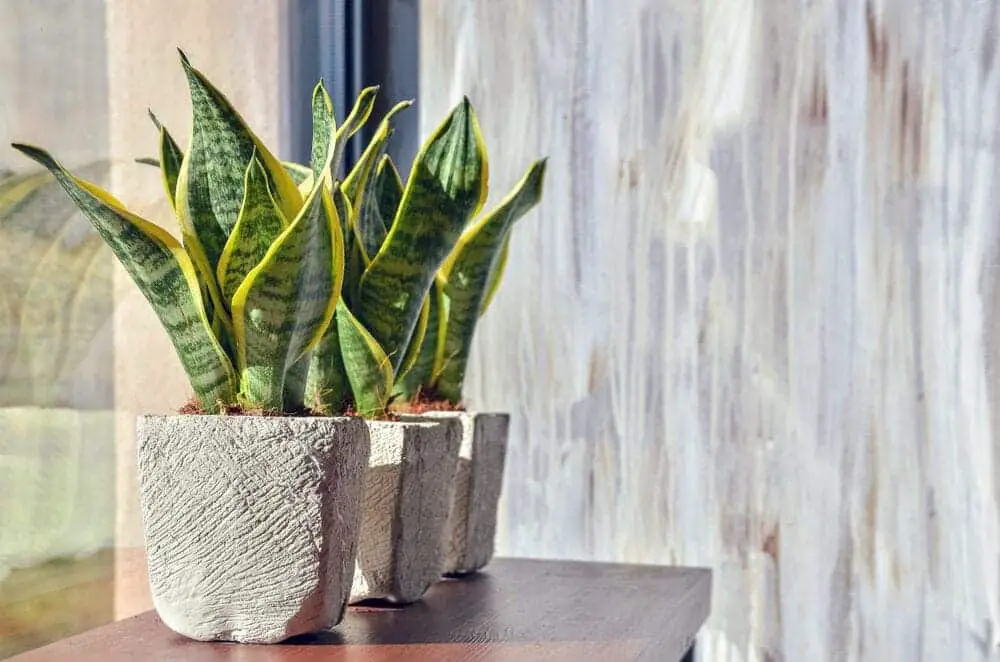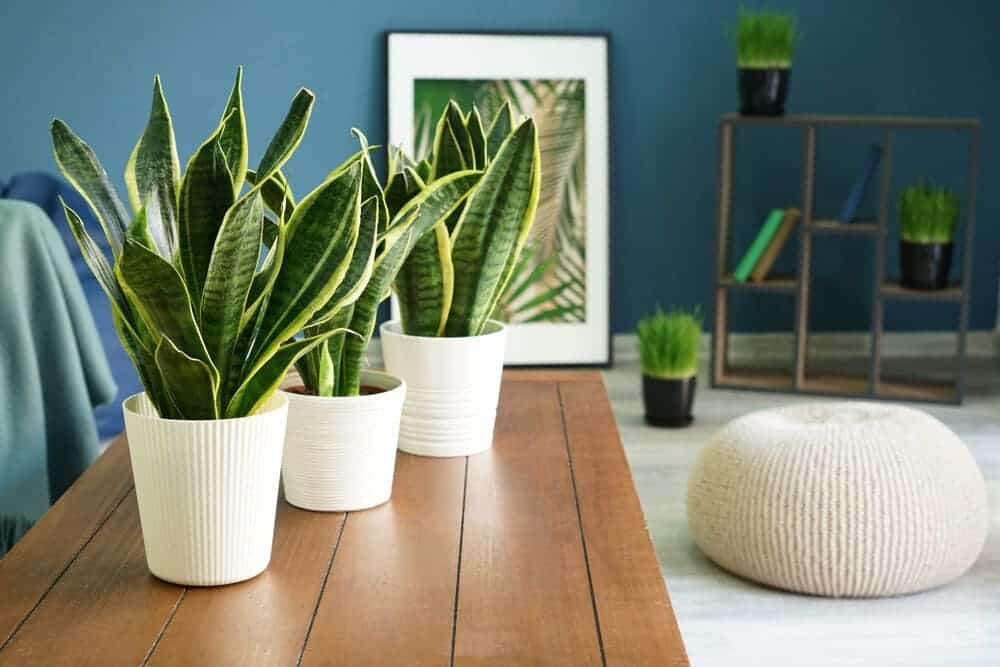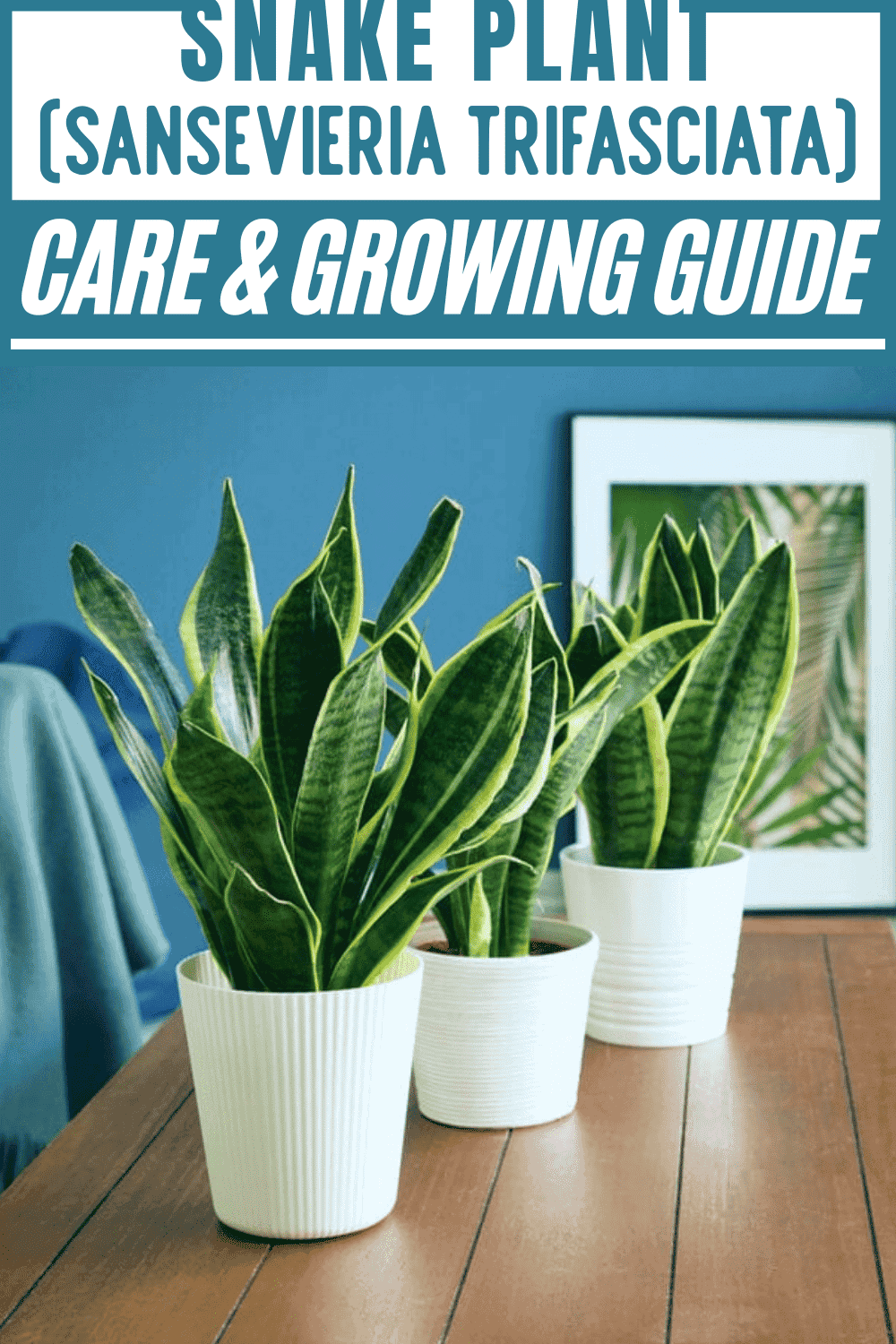The Snake Plant is a great houseplant that looks great and doesn’t take a tremendous amount of effort to care for.
This plant is also known as St. George’s Sword, and it is native to West Africa. In this article you will learn everything you need to know about growing and caring for these plants.
Snake Plant Care & Growing Guide
1. Light Requirement
You will need to give your plant a steady stream of bright but indirect sunlight for it to stay healthy and thrive. If you are going to grow this plant outside, make sure that you keep it in a semi-shady spot.
Too much direct sunlight can do a lot of harm to the leaves of this plant. These plants can even do pretty well when they are kept in full shade.
2. Water
You should allow the soil your plant is in to become at least somewhat dry before watering it. You’ll only need to water it about once each month during the winter months. Overwatering is a common cause of death among these plants, as it causes root rot to set in quickly.
3. Climate
These plants prefer tropical climates, as they are native to West Africa. Blazing warm sun and high humidity are perfect conditions for this plant to thrive.
4. Soil
Make sure that you keep this plant in the well-drained potting mix so that it remains as healthy as possible. You can use sandy soil as well, so that is something to consider. An all-purpose cactus potting soil is yet another option that will work very well.
5. Temperature
Snake plants tend to do best when they are kept within a temperature range of 60 to 80 degrees Fahrenheit during the day and 55 to 70 degrees at night. These plants don’t tolerate very cold temperatures well, as they originate from a tropical region of the planet.
6. Repotting
When you are going about repotting your snake plant, make sure that you pick a container that is made of a very durable material. The roots of this plant have been known to crack flimsier containers.
While these plants do not require repotting very often, it might be needed if yours is outgrowing its pot. You will want to do this in spring with a container that is one size up. Remember to put in fresh potting mix as well.

7. Speed of Growth
You can grow a snake plant pretty quickly when you give it bright sunlight for six hours each day. When these plants are put out in full sunlight, they tend to grow the fastest.
8. Height and Spread
The average snake plant grows 1 to 3 feet tall, though it can get as big as 8 feet tall. These plants have a spread of anywhere from six inches to three feet.
9. Flowers
While snake plants do not bloom very often, it is possible for them to produce flowers. Sometimes buds will form on the flower stalk of these plants. The green and white flowers are actually pretty unique looking and beautiful overall.
10. Trimming
If you ever see any dying leaves on your snake plant, you’ll want to cut them off with a thin knife right away. You need to be very cautious when doing this so you don’t accidentally harm nearby healthy leaves.
You can use the leaves that you trim from this plant to grow new ones. In addition to diseased leaves, you’ll also want to cut off ones that are too long. This will help with maintaining the best possible aesthetic for your snake plant.
Are Snake Plants Poisonous?
Keep in mind that snake plants are in fact poisonous. While adults need to consume a lot of this plant for it to be life threatening, children and pets don’t have to eat as much.
You should, therefore, be very careful about keeping it in or around your home if you have cats, dogs or small children. Some of the signs of a toxic reaction include nausea, vomiting, lack of appetite, and swollen tongue and/or throat.

Can Snake Plants Grow in Water?
Snake plants can be actually be grown in water fairly easily. First you’ll want to put the leaf in a vase with a few cups of water. Make sure that you keep the vase near a window that receives bright sunlight, but not too close. Replace the water inside of the vase every two days. Eventually you’ll begin to see roots form.
How to Get Snake Plants to Flower
As strange as it might seem, the best way to get a snake plant to flower is to neglect it. You’ll want to provide it with lots of light and no water. While there is no guarantee that it will bloom, this will give you the best chance of seeing flowers.
Common Snake Plant Diseases
Keep in mind that root rot is a major issue with snake plants in general. If root rot starts becoming a problem, you will notice some of the plant’s leaves turning brown or yellow. Remove the rotting leaves right away, and repot the plant using new potting mix.
More like this: Starfish Sansevieria
Conclusion
- Snake plants do very well when they are in bright but indirect sunlight.
- These plants can thrive even when they are put in full shade.
- You should limit watering this plant to once every month in the winter.
- Make sure that the plant’s soil is somewhat dry before watering it.
- The ideal temperature range for this plant is 60 to 80 degrees in the daytime and 55 to 70 degrees at night.
- The average snake plant gets about three feet tall and six inches to three feet wide.
- Cut off any leaves that are getting too long or rotting (showing brown spots).
- Since these plants are considered poisonous, you should be careful about keeping them around kids or pets.
- If you want to get your snake plant to flower, provide it with maximum sunlight and minimal water.

Victoria is the owner and main author of hobby plants. She loves spending her free time in her garden planting and taking care of her plants. Victoria hopes you enjoy the content here!
![Can Snake Plants Live Outside? [COMPLETE CARE GUIDE] Can Snake Plants Live Outside? [COMPLETE CARE GUIDE]](https://www.hobbyplants.com/wp-content/uploads/2022/08/can-snake-plants-live-outside-300x158.jpg)
![How To Propagate Snake Plant? [BEGINNER'S GUIDE] How To Propagate Snake Plant? [BEGINNER'S GUIDE]](https://www.hobbyplants.com/wp-content/uploads/2022/08/how-to-propagate-snake-plant-300x158.jpg)
![How to Repot A Snake Plant? [STEP BY STEP GUIDE] How to Repot A Snake Plant? [STEP BY STEP GUIDE]](https://www.hobbyplants.com/wp-content/uploads/2022/08/how-to-repot-snake-plant-300x158.jpg)

![How Often Do You Water A Snake Plant? [FIND OUT HERE] How Often Do You Water A Snake Plant? [FIND OUT HERE]](https://www.hobbyplants.com/wp-content/uploads/2022/07/how-often-do-you-water-a-snake-plant-1-300x158.jpg)
![Mother Of Thousands Plant [Complete Plant Care Guide] Mother Of Thousands Plant [Complete Plant Care Guide]](https://www.hobbyplants.com/wp-content/uploads/2022/07/mother-of-thousands-plant-300x158.jpg)
![Majesty Palm Plant Care: [Complete Beginner's Guide] Majesty Palm Plant Care: [Complete Beginner's Guide]](https://www.hobbyplants.com/wp-content/uploads/2022/08/majesty-palm-care-300x158.jpg)
![Exotic Angel Plant Care: [Complete Beginner's Guide] Exotic Angel Plant Care: [Complete Beginner's Guide]](https://www.hobbyplants.com/wp-content/uploads/2022/08/exotic-angel-plant-care-300x158.jpg)
![Snow White Waffle Plant: [Complete Care Guide] Snow White Waffle Plant: [Complete Care Guide]](https://www.hobbyplants.com/wp-content/uploads/2022/08/snow-white-waffle-plant-300x158.jpg)
![Waffle Plant Care: [Complete Beginner's Guide] Waffle Plant Care: [Complete Beginner's Guide]](https://www.hobbyplants.com/wp-content/uploads/2022/08/waffle-plant-300x158.jpg)
![Bird Of Paradise Plant Care: [Complete Beginner's Guide] Bird Of Paradise Plant Care: [Complete Beginner's Guide]](https://www.hobbyplants.com/wp-content/uploads/2022/08/bird-of-paradise-plant-300x158.jpg)
![Purple Passion Plant Care: [Complete Beginner's Guide] Purple Passion Plant Care: [Complete Beginner's Guide]](https://www.hobbyplants.com/wp-content/uploads/2022/08/purple-passion-plant-care-300x158.jpg)